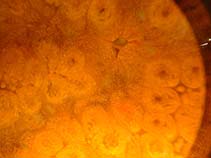Aplidium californicum (Ritter & Forsyth, 1917)
California sea pork
Classification / Names Common names | Synonyms | CoL | ITIS | WoRMS
Ascidiacea | Aplousobranchia | Polyclinidae
Environment: milieu / climate zone / depth range / distribution range Ecology
Sessile. Temperate
Distribution Countries | FAO areas | Ecosystems | Occurrences | Introductions
Pacific Ocean: New Caledonia, Canada and USA.
Length at first maturity / Size / Weight / Age
Maturity: Lm ? range ? - ? cm Max length : 2.0 cm COLD male/unsexed; (Ref. 2268)
Life cycle and mating behavior Maturity | Reproduction | Spawning | Eggs | Fecundity | Larvae
Main reference
References | Coordinator | Collaborators
Lambert, G. 2003 New records of ascidians from the NE Pacific: a new species of trididemnum, range extension and redescription of Aplidiopsis pannosum (Ritter, 1899) including its larva, and several non-indigenous species. Zoosystema 25(4):665-679. (Ref. 1749)
IUCN Red List Status
(Ref. 130435: Version 2025-1)
CITES status (Ref. 108899)
CMS (Ref. 116361)
Threat to humans
Human uses
| FishSource |
Tools
More information
Diet composition
Food consumption
Predators
Max. ages / sizes
Length-weight rel.
Length-length rel.
Length-frequencies
Mass conversion
Abundance
Internet sources
BHL | BOLD Systems | CISTI | DiscoverLife | FAO(Publication : search) | Fishipedia | GenBank (genome, nucleotide) | GloBI | Gomexsi | Google Books | Google Scholar | Google | PubMed | Tree of Life | Wikipedia (Go, Search) | Zoological Record



